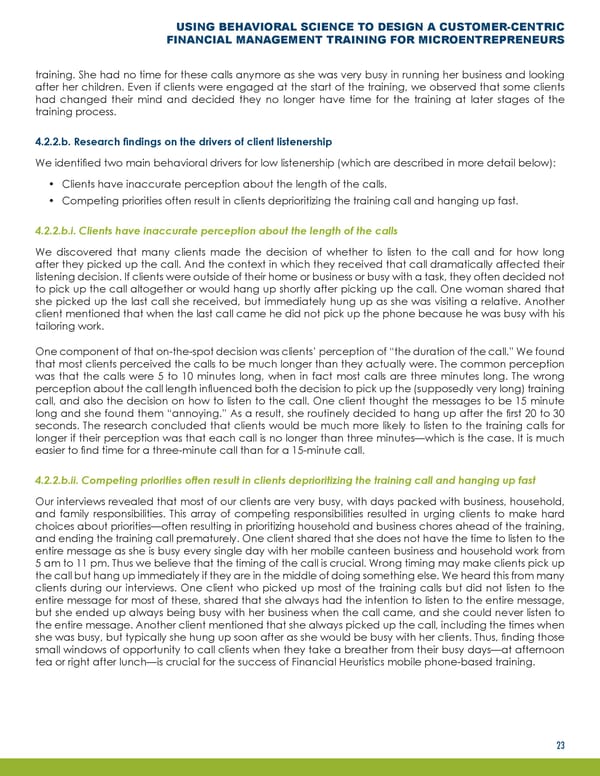USING BEHAVIORAL SCIENCE TO DESIGN A CUSTOMER-CENTRIC FINANCIAL MANAGEMENT TRAINING FOR MICROENTREPRENEURS training. She had no time for these calls anymore as she was very busy in running her business and looking after her children. Even if clients were engaged at the start of the training, we observed that some clients had changed their mind and decided they no longer have time for the training at later stages of the training process. 4.2.2.b. Research findings on the drivers of client listenership We identified two main behavioral drivers for low listenership (which are described in more detail below): • Clients have inaccurate perception about the length of the calls. • Competing priorities often result in clients deprioritizing the training call and hanging up fast. 4.2.2.b.i. Clients have inaccurate perception about the length of the calls We discovered that many clients made the decision of whether to listen to the call and for how long after they picked up the call. And the context in which they received that call dramatically affected their listening decision. If clients were outside of their home or business or busy with a task, they often decided not to pick up the call altogether or would hang up shortly after picking up the call. One woman shared that she picked up the last call she received, but immediately hung up as she was visiting a relative. Another client mentioned that when the last call came he did not pick up the phone because he was busy with his tailoring work. One component of that on-the-spot decision was clients’ perception of “the duration of the call.” We found that most clients perceived the calls to be much longer than they actually were. The common perception was that the calls were 5 to 10 minutes long, when in fact most calls are three minutes long. The wrong perception about the call length influenced both the decision to pick up the (supposedly very long) training call, and also the decision on how to listen to the call. One client thought the messages to be 15 minute long and she found them “annoying.” As a result, she routinely decided to hang up after the first 20 to 30 seconds. The research concluded that clients would be much more likely to listen to the training calls for longer if their perception was that each call is no longer than three minutes—which is the case. It is much easier to find time for a three-minute call than for a 15-minute call. 4.2.2.b.ii. Competing priorities often result in clients deprioritizing the training call and hanging up fast Our interviews revealed that most of our clients are very busy, with days packed with business, household, and family responsibilities. This array of competing responsibilities resulted in urging clients to make hard choices about priorities—often resulting in prioritizing household and business chores ahead of the training, and ending the training call prematurely. One client shared that she does not have the time to listen to the entire message as she is busy every single day with her mobile canteen business and household work from 5 am to 11 pm. Thus we believe that the timing of the call is crucial. Wrong timing may make clients pick up the call but hang up immediately if they are in the middle of doing something else. We heard this from many clients during our interviews. One client who picked up most of the training calls but did not listen to the entire message for most of these, shared that she always had the intention to listen to the entire message, but she ended up always being busy with her business when the call came, and she could never listen to the entire message. Another client mentioned that she always picked up the call, including the times when she was busy, but typically she hung up soon after as she would be busy with her clients. Thus, finding those small windows of opportunity to call clients when they take a breather from their busy days—at afternoon tea or right after lunch—is crucial for the success of Financial Heuristics mobile phone-based training. 23
 Using Behavioral Science to Design a Customer-Centric Financial Management Training for Microentrepreneurs Page 25 Page 27
Using Behavioral Science to Design a Customer-Centric Financial Management Training for Microentrepreneurs Page 25 Page 27